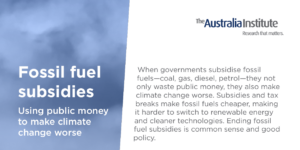Australia’s farcical climate policy: market forces to cut emissions and subsidies to destroy carbon sinks

Climate change often gets blamed on market failure, but government failure plays a pretty big role as well. Not only do Australian governments spend more than $11.6 billion per year subsidising fossil fuels, at the same time the Federal Government spends billions paying some landholders to grow more trees, state governments perversely continue to subsidise the logging of native forests. I’m not sure that’s what people mean by the circular economy.
While successive governments have spent billions subsidising research into Carbon Capture and Storage (CCS), the really inconvenient truth is the most effective CCS technology is the humble tree. It’s low cost, low risk and ready to roll. Trees quite literally suck carbon dioxide out of the air and store it safely in their trunks and their roots. And as if that’s not a cool invention, trees throw in water filtration and native species habitat ‘services’ for free. If Elon Musk had invented the tree, he’d be a trillionaire by now.
But despite all the talk of doing everything we can to tackle climate change in reality our state governments are still spending our money to subsidise the logging of native forests. Last year alone Victorian taxpayers spent $18m propping up state owned logging operations. Those subsidies are expected to balloon out to $192m in total by 2030. According to the publicly owned VicForests own business plan for 2015-16 ‘Timber harvesting operations in the East Gippsland Forest Management Area have not been profitable for VicForests for many years.’ Tasmania and NSW forestry receive similarly eye-watering subsidies.
Most of the trees from native forests logging get turned into wood chips to make paper. But while there are lots of substitutes for native forest woodchips, there is no substitute for our remaining native forest habitats which are literally the only places on the earth countless species can live. And those same forests the only places on earth that can filter and purify the water that runs into the dams that provide most of our drinking water.
The former and current federal governments have committed up to $4.5 billion to encourage some farmers to ‘avoid deforestation’ and ‘induce regeneration’ of trees on their land. But while preventing further land clearing and encouraging better land management is a great idea, there is strong evidence that there’s a lot less new trees in the landscape than the farmers and the government are claiming.
In Western NSW, for example, where around $300 million has been committed to paying farmers to ‘avoid deforestation’, the rate of land clearing has actually increased! One farmer who receives millions from the federal government for his efforts explained the parent paradox when he admitted to the ABC that he was using the money he got from ‘avoiding deforestation’ on one of his paddocks to clear more trees on a neighbouring block.
But while there is so much doubt about the integrity of the Morrison Governments so called Emission Reduction Fund that the new Minister, Chris Bowen, has announced a 6-month inquiry, there is absolutely no doubt that when chainsaws bring down 45-meters tall trees in poor native forests that enormous amounts of greenhouse gasses are released back into the atmosphere. Australia isn’t investing in its best carbon capture technologies; it is literally destroying them.
Even if we didn’t want to reduce greenhouse gas emissions the idea that the federal government would pay some people to protect trees while the state governments pay others to destroy them would be absurd. But when all of the state governments concerned claim to be committed to achieving net-zero by 2050 the whole situation is simply farcical.
The Commonwealth’s emission reduction fund was dreamed up by Tony Abbott’s government, criticised by Malcolm Turnbull, but maintained for now by Labor due to the political toxicity of introducing a simple carbon price. But while the entire premise of the ERF is that market forces have a significant role to play in tackling climate change, supporting government subsidies to keep our native forest logging industry going is the antithesis of believing in the role of market forces.
But of course, Australia’s native forests are not just the best ‘carbon sinks’ around. For example, the Victorian highlands purify more than $310m worth of drinking water, provide the only habitat in the world suitable for bush-stone curlews, bandicoots, spot-tailed quolls, regent honey-eaters, greater gliders and over third of Victoria’s plant species. And, of course, have priceless importance for indigenous heritage and culture.
The economics of tackling climate change aren’t complicated, we simply need to do less of the things that increase emissions and more of the things that reduce them. While a carbon tax is obviously a good idea, in the meantime we need to scrap the subsidies that encourage native forest logging and extracting even more fossil fuels. But while the economics aren’t complicated, the politics and the policies favoured by the biggest polluters, always are. Scrapping subsidies for fossil fuels and native forest logging aren’t the only things we need to do to make our planet safe, but no government can pretend to be serious about achieving net zero emissions.
Richard Denniss is Chief Economist at leading public policy think-tank the Australia Institute Twitter: @RDNS
Between the Lines Newsletter
The biggest stories and the best analysis from the team at the Australia Institute, delivered to your inbox every fortnight.
You might also like
Climate target malpractice. Cooking the books and cooking the planet.
As the Albanese government prepares to announce Australia’s 2035 climate target, pressure is mounting to show greater ambition.
Fossil fuel subsidies
When governments subsidise fossil fuels—coal, gas, diesel, petrol—they not only waste public money, they also make climate change worse. Subsidies and tax breaks make fossil fuels cheaper, making it harder to switch to renewable energy and cleaner technologies. Ending fossil fuel subsidies is common sense and good policy.
How the government is setting everyone up to fail on green claims
If a private company ran a scheme that misled consumers, inflated investor confidence, and exposed its clients to legal risk, we would expect the government to shut it down.



